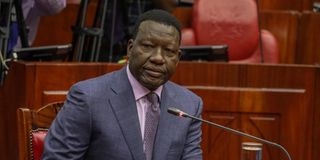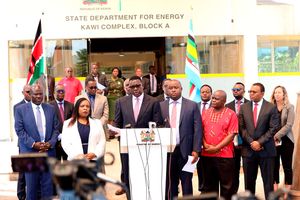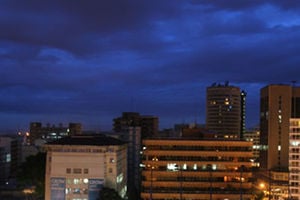
A dark Kisumu street in a past power blackout.
A plan by Kenya Power to introduce load-shedding in a country with excess generation, has painted the grim picture of Kenyans grappling with high electricity bills even as Auditor-General Nancy Gathungu questioned high invoices customers are slapped with.
Energy Cabinet Secretary Davis Chirchir said western Kenya will be a victim of load-shedding following a trip in the line in the second week of December.
“Load shedding is a short-term solution that will ensure we do not plug the country into blackouts . . . Generation is not our problem. We have enough power but the challenge is more on transmission where we are using historically built lines to power western region,” Mr Chirchir told journalists after a December 2023 blackout, the sixth in three years.
But for Kenya, the increasing number of blackouts is not just about the cost of businesses and the inconvenience it comes with, it also boils down to what they pay at the metre—and hence what to expect from the utility firm.
In August, Ms Gathungu shocked a parliamentary committee probing the high cost of electricity in the country when she revealed that consumers are paying for electricity bills that they did not consume and Kenya Power cannot trace the same.
She told MPs that customers are overburdened by bills that do not match their actual consumption and neither Kenya Power nor Energy and Regulatory Authority (Epra) seems to be having answers on the anomaly.
It is, however, ironic that while MPs are investigating why Kenyans are paying for idle generators by the Independent Power Producers (IPPs), the country has occasionally been plunged into in blackouts that have lasted for over 10 hours.
Mr George Aluru, the chief executive Electricity Sector Association of Kenya, told the Nation that the only way out to deal with the power outages is to build more power lines especially in the western region.
Mr Aluru said the high demand of power in western region should prompt the government to fastrack power lines set up in the area and also support those generating own power rather than resorting to rationing.
He also blamed poor investment in building of transmission lines and the numerous court cases by contractors that have seen delays in some of those projects.
“We need to finish our power lines as soon as possible and also change the power system to a more consumer oriented one,” Mr Aluru said.
National Assembly Energy Committee chairman Vincent Musyoka told the Nation that the power outages can be attributed to three factors-human resource issues, transmission lines and the control centre.
“In the first supplementary budget, we allocated the Ministry of Energy Sh300 million for building transmission lines. They need to be put to account on why the country cannot double its transmission line for the evacuation of power to avoid overload,” Mr Musyoka said.
Mr Musyoka said when there was a national blackout on December 10, the country had excess power of 100 megawatts but there was no line to evacuate it to the areas needed.
“We need to get answers from the ministry, when will the building of the lines start and when will they be completed?” He asked.

Cabinet Secretary Davis Chirchir.
The MP pointed out that the best engineers in the energy sectors have been poached by other countries that offer them better terms.
On the control centre, Mr Musyoka said it has failed to effectively deal with power collection and distribution in the country.
“There is a computer that shows the demand and supply of power in the entire country, why should they wait until there is a national blackout. If one line has a problem,why should it affect traders in Mombasa? These are the questions that we honestly must answer as a country to avoid future outages.”
The latest national blackout experienced in the country on December 10 , which was the sixth in three years, sparked major outrage not only among industries who complained of the losses but also within the government.
The outage, according to Chirchir, was caused by an overload of the Kisumu-Muhoroni transmission line.
The line is meant to carry 80 megawatts but at that time was transmitting 149 megawatts, a move that saw the line trip affecting the entire network.
The National Assembly Energy committee on the following day sent a flurry of letters to the two PSs in charge of petroleum and Energy respectively demanding an explanation through a preliminary report within 24 hours.
According to the resolutions by the Cabinet, the only answer to the frequent power outages is through unbundling of the power transmission systems.
The Cabinet argued that such a move would mean that a power blackout in one area does not affect the entire country hence minimise the pain caused during such occasions.
Appearing before the committee in September following another national blackout that occurred on August 25, Chirchir told MPs that after investigation by the team of engineers, it was established that the outage was caused by tripping of the dynamic reactive power compensation at Lake Turkana Wind Power (LTWP) substation.
In June this year, the National Assembly committee on Energy started a probe on the high cost of electricity in the country.
Mr Musyoka said the report is largely done explaining that they have taken longer as they are also preparing legislative proposals on how to implement it.
“We don’t want to produce just another report like other committees have done and leave it there. Our report which will be ready soon has legislative proposals on how to implement each recommendation that we have made,” Mr Musyoka said.
“Once something is in law, then it is implementable, the tragedy with other reports is that they just make recommendations without a way forward and everything ends in parliament upon tabling of the report,” he added. At the start of their probe, the committee trained their guns on the Independent Power Producer (IPPs) whom they accused of getting into expensive Power Purchasing Agreements (PPAs) with the government but did not deliver.
Despite IPPs charging the higher capacity charges, a cost which is passed to the consumer, the Auditor General told MPs that they were operating below their contracted capacity.
This means that consumers are paying IPPs more for capacity charges than the actual electricity they sell to Kenya Power.
“It was noted that the capacity charge costs for Independent Power Producers during the two years (2020/2021 and 2021/2022) were higher than the cost of the energy purchased indicating that the IPPs were operating below their contracted capacity resulting in payment for idle capacity,” the auditor said.
According to the audit report for the financial year 2019/2020, taxpayers paid Sh47.5 billion to IPPs as capacity charge and Sh49.2 billion in the 2020/2021 financial year.
“Any idle capacity on the IPP is borne by the consumer due to capacity charge contractual obligation and will extend through the contract which is normally 20 to 25 years,” Ms Gathungu told MPs.
Capacity charge is the amount that is payable to an IPP regardless of whether they generate power or not. It prescribes the minimum power that expected to add to the national grid and pays for it regardless of whether there is underproduction.












